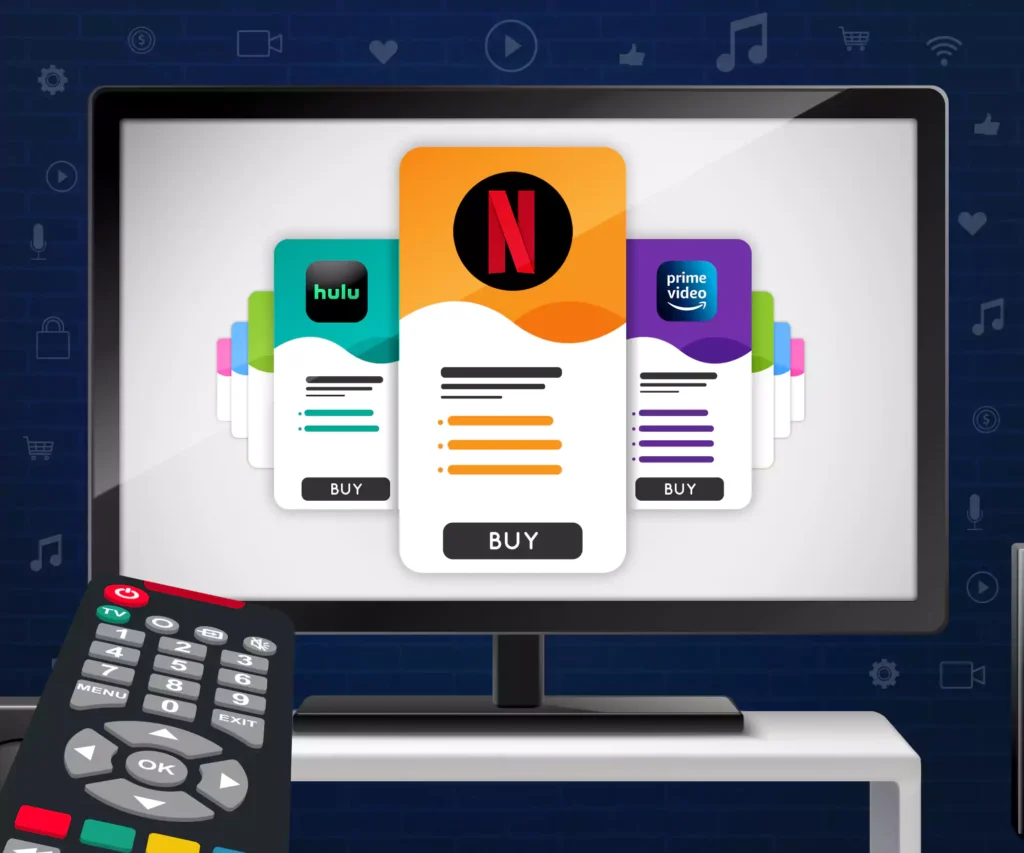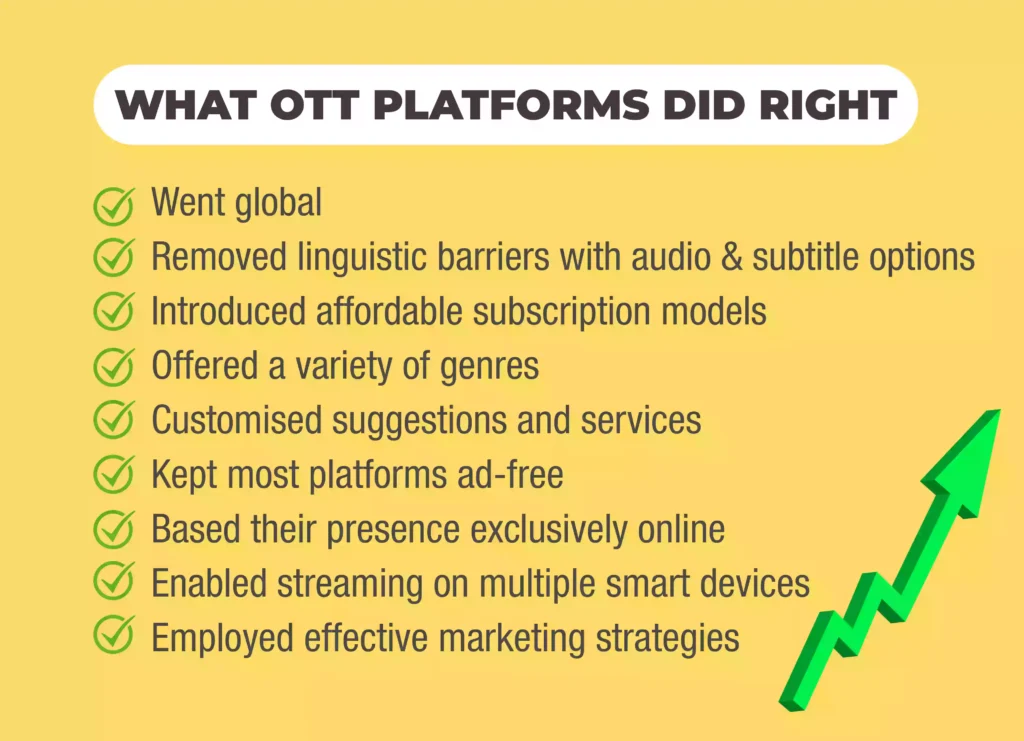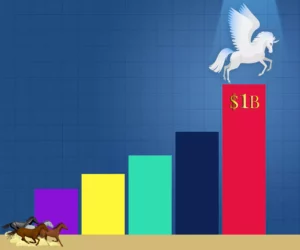
In the 1930s, the world was introduced to television, an intriguing discovery that offered the pleasure of audio and visual. Then, TV became a paid pleasure with limited options. However, surpassing all the limitations of wired entertainment, we have shifted to the wireless world. Now, through OTTs, we can view movies, web series, documentaries, and more on various devices, including mobiles, tablets, TVs, and web browsers. OTT subscription models have hooked millions of eyeballs across the globe. But have you ever wondered how this genie on our smart devices makes money? Let me drive you through the intricacies of the OTT world.
What are OTT platforms?
Over-the-Top (OTT) is a digitised form of watching or listening to entertaining content. Unlike wired services and cable operators, OTT services are purely run on the internet. It goes ‘over the top’ of existing internet services to provide entertainment content for viewers. Now, how have these platforms become lucrative businesses?
Well, by making these moves:

OTT subscription-based models
While Netflix follows a straightforward subscription model, competitors like Apple TV+, Hulu, and many others follow other models that give the audience the option to choose or purchase as per their choice. The following are the subscription models adopted by various OTT platforms worldwide.
Subscription-based Video on Demand (SVOD):
In this model, the payment plan operates on a monthly or yearly subscription. On such OTT platforms, the individual has unrestricted access to movies, podcasts, live events, and a wide range of global series. For example, the Netflix subscription model has a fixed price that varies according to the type of device and user capacity. Once you pay, you can view all the available content. Moreover, it’s an ad-free zone that makes it a dearer and preferred OTT platform.
Advertising-based Video on Demand (AVOD):
The viewer has the freedom to access every piece of content available without paying. But, the drawback is that they have to sit through advertisements. YouTube is the classic example of AVOD because it’s an unpaid platform where you can access multiple types of content. Even the ‘Skip Ad’ option pops up only after a few seconds of viewing the ad.
Transaction-based Video on Demand (TVOD):
This is similar to renting. In this streaming service, the viewer only pays for the movie or any other entertainment material they wish to watch on a fixed pay-per-view model. This OTT subscription model works like a vending machine where you pay for your choice. Google Play is one such platform in the OTT world. It offers the option to buy or rent movies where the viewer has to pay only for their pick without being a regular subscriber.
Hybrid Model:
This OTT subscription model combines any of the models mentioned above. For example, Peacock, an American OTT platform, provides three levels of service: Peacock, which delivers free content with advertising; Peacock Premium, which provides a broader collection of content with advertising; and Peacock Premium Plus, which offers all the movies and shows without commercials. Other established OTT platforms are also considering this hybrid model. Take Netflix, for example. In the first fiscal quarter of 2022, this emperor of OTTS faced a heavy loss of 2,00,000 subscribers. Due to the subsequent fall in stock value, Netflix plans to revamp itself with a pocket-friendly subscription model, including advertisements and curbing/limiting password sharing among its subscribers.
Consumer behaviour and rising OTT subscriptions
With the pandemic leading to the introduction of the WFH culture and online schooling, we find ourselves glued to OTT platforms and social media like never before. An average American spends almost one work week watching videos on mobile applications, consuming 38 hours of content each month. A large percentage of OTT video viewers are in the 15-30 age group. Besides being the tech-savvy demographic, due to online education, nowadays, almost every student has a smartphone or a laptop. The OTT industry has run targeted marketing campaigns to cash in on this spike in the use of digital devices. Another kind of consumer behaviour observed is that dedicated viewers engage with OTT providers’ social media profiles. Such behaviour directs the advertising and marketing groups to aim, attract, and hook consumers in the purchase cycle.
As a result, the OTT world is moving towards monumental growth, with expectations of surpassing $210 billion in revenue by 2026. If you compare it to the valuation in 2020 ($106 billion), that is a twofold increase. OTT’s largest markets are Asia-Pacific, the Philippines, Indonesia, and Australia. Regarding the UAE base for the OTT industry, over 2019 and 2020, Emirati (SVOD) subscribers have climbed by 35%, and the market produced about $60 million. Starz Play, Shahid VIP, and Apple TV+ lead the OTT market in the UAE, accounting for more than 68% of total subscribers.
In the Asia-Pacific region, OTT business is expected to increase by 90% ($54 billion) by 2026. In addition, Western Europe will have over 96.3 million OTT subscribers by 2024. Latin America will also witness over 116 million OTT streamers by 2026, followed by Brazil and Mexico. In the UAE, a rapid increase in subscriptions has been forecasted, a leap from 69% in 2020 to 145% by 2026.
Is it the End of the Television Era?
Television had a good run till the late 2000s. Fast-forward a decade or two, however, and increasing internet reach in tandem with mobile manufacturing is leading to its passive death. OTT seems like the next big thing, but many questions about the longevity of the OTT phase remain. Nevertheless, the stats show that OTT is the next step forward in entertainment. With many more additions, removals, and experiments in the offing, it does appear that way, doesn’t it?


